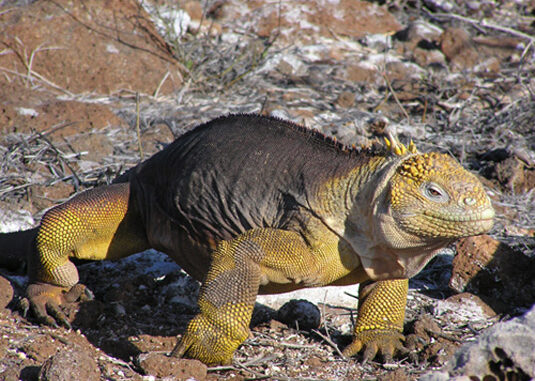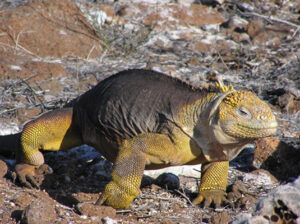

Richard Brommer
A land iguana
The Galápagos Islands are the ultimate destination for the scientist, animal lover, photographer, outdoor enthusiast, or just plain adventurer. The island chain sits on a volcanic hot spot on the equator in the Pacific Ocean, more than 600 miles from the coast of Ecuador. There are nineteen islands and many smaller islets in the chain, which spreads out over an area the size of the state of Indiana.
From December to May, the Galápagos have a warm tropical climate. During these months, the sea is calm and warm. From June to November, the oceanic Humboldt Current cools the water, bringing clouds and the highland mists known as garúa. Centuries ago, pirates looking for hideouts called the Galápagos las Islas Encantadas because they were shrouded from view by these mists.
A UNESCO World Heritage site, the isolated Galápagos are home to an incredible variety of animal species, many of which have evolved differently from the same species on the mainland. Besides the seals and sea lions, there are gigantic tortoises, equatorial penguins, flightless birds, and lizards that swim in the ocean! The ecosystem of the Galápagos has been the subject of much scientific study and environmental and conservation research.
The traveler can stay in town on Isabela, Santa Cruz, or San Cristóbal islands, or camp in regulated areas. Outdoor enthusiasts can sail, swim, snorkel, surf, or scuba dive on the coast or go mountain biking in the highlands. The curious budding scientist can visit the field station on Santa Cruz, or the Giant Tortoise Breeding Center on Isabela. And clearly, any visitor to these islands would want to explore the islands and photograph the wildlife.
Explore More:
Search online for Web sites with cyber field trips to the Galápagos and take a virtual tour. Prepare a “wish list” in Spanish of all the things you would do and see in the Galápagos Islands if you were to go there. Share your list with your classmates.
Share What You Know:
El Niño is a warm ocean current that affects the Galápagos climate. Go online and find out about the impact El Niño has on plant, bird, animal, and marine life in the Galápagos. Share your findings, in Spanish if possible, with your class.